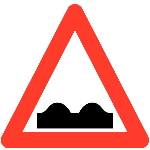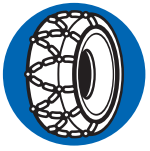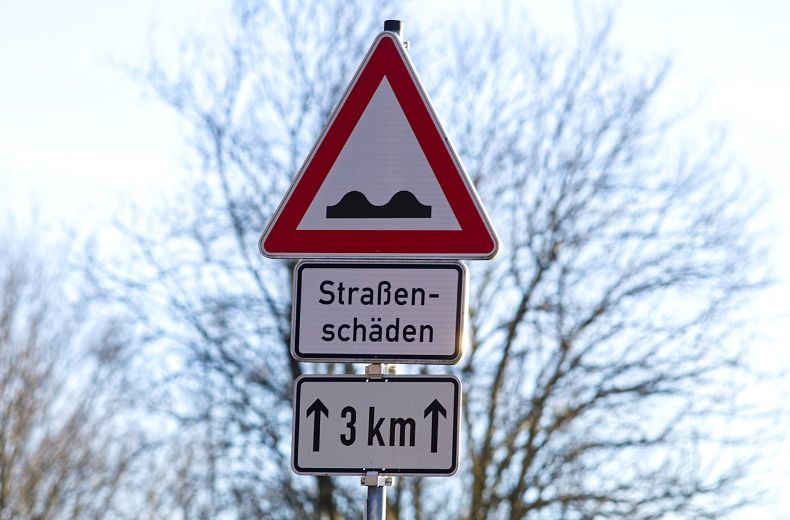Our guide to German road signs is designed to make your adventure stress-free so you can concentrate on making memories.
Read our helpful driving in Europe guide for more advice on driving in Germany.
‘Speed limit’ signs

German maximum speed limit signs are identical to those we use in the UK except for one key difference: the limits are given in kilometres per hour (km/h) rather than miles per hour (mph).
‘National speed limit’ or ‘End of all restrictions’ sign

This sign looks very similar to our own ‘National speed limit’ sign but uses multiple black stripes rather than one. When you see this sign, all previous speed limits and passing restrictions no longer apply.
‘Minimum speed limit’ sign

Another sign that looks like our own. The blue circle displays a minimum speed limit (in km/h) in a white font that your vehicle must be capable of travelling at on the affected area of road.
‘Yield’ sign

The yield sign is a simple red triangle with a white background pointed downwards. When you see this sign make sure you give way to oncoming and crossing traffic.
‘Stop’ sign

No prizes for guessing what to do when you see this one. You’ll find the red octagon with the word ‘STOP’ in white beside clear markings on the road showing you where to stop your vehicle.
‘Uneven road’ sign

Two bumps in a red triangle indicate that the road surface ahead is uneven. Try lowering your speed and pay close attention to any lumps and bumps beneath you to ensure you don’t sustain any avoidable damage.
‘General warning’ sign

If you see a red triangle pointed upwards with an exclamation mark in the middle look out for a second sign. The ‘general warning’, or ‘danger ahead’ sign, appears next to more information to let you know about hazards further ahead.
‘Migrating amphibians ahead’ sign

This one shouldn’t take much decoding. A red triangle with a picture of a frog inside is designed to warn you that amphibians may appear on the road ahead. Reduce your speed and keep an eye on the road to try and prevent an unwanted accident.

Instant cover available
• 24/7 rescue at the roadside
• Help to get home if your vehicle can't be fixed
• 5 star Defaqto rated cover

‘Max width’ and ‘Max height’ signs


‘Max width’ and ‘Max height’ signs, sometimes called ‘vertical clearance’ and horizontal clearance’ signs, work very similarly to the equivalent signs in the UK. Remember though, the measurements given are metric (metres and centimetres) rather than the imperial (feet and inches) that we’re used to.
‘Snow chains required’ sign

One of the more unique signs on the German road network is also rather easy to understand. The tyre covered in chains on a blue circle, is a sign that snow chains must be fitted to your car.
The maximum speed limit for affected roads is 50 km/h.
‘Traffic restriction zone’ sign


In some of Germany’s major cities it’s a legal requirement for cars to display ‘Umweltplakette’ or emissions stickers. The signs appear next to a second sign to let drivers know which types of cars are permitted within a controlled zone.
A black and white version of the sign with a band of diagonal stripes indicates the end of a restriction zone.
Find out more about German emissions stickers.
‘Minimum following distance’ sign

This sign won’t affect your average driver from the UK on a German road trip but it tells drivers of vehicles weighing more than 3.5 tonnes, that they should maintain a minimum distance from vehicles in front of them.
Measurements are given in metres.
‘No stopping’ and ‘No waiting’ signs


These two signs look very similar apart from one key difference.
The sign which features two diagonal lines indicates that there’s no stopping or parking allowed. The sign with one diagonal line, the ‘no waiting’ or ‘no parking’ sign, allows a short wait of three minutes only.
Both signs apply to the side of the road they appear on, unless they are accompanied with the word ‘ZONE’, in which case rules apply to the whole of the signposted area.
‘Priority at next intersection’ sign

A wide arrow intersected with a thin line is designed to give you right of way at the next intersection. Keep your eyes peeled for this red triangle sign.
‘Priority road at the intersection’ sign

This unusual sign may look like an angry emoji tilted at an angle, but the thicker line is designed to show the course of a priority road.
In the example above, the priority road is turning to the left. This line can appear in different directions according to the layout of the road. If you’re planning on leaving the priority road, you’ll need to use your indicators.
‘Priority road starts’ sign

This yellow diamond indicates the start of a priority road at all upcoming intersections before the ‘End of priority’ sign.

It features three horizontal stripes to show that the priority road has ended.
‘Unmarked intersection ahead’ sign

A black cross on a white triangle indicates an unmarked or uncontrolled intersection or junction.
If you see the sign, lower your speed and prepare to give way to traffic approaching from the right-hand side.
Top tips for German road signs
Most signs are easily understandable on the German road network. however, there are a few of them that might be a bit confusing.
If you see a yellow circular sign with a green border and the letter 'H' in green, then it indicates that there is a bus or tram stop.
For travellers driving across the country, a yellow rectangular sign with a black border and the word 'Umleitung' in black signifies a diversion is in place due to road works. However, a blue rectangular sign with a white upward-pointing arrow, the letter 'U', and a white figure indicates a diversion for motorway traffic.
A green-bordered inverted triangle bearing the image of a flying eagle and the words 'Landschafts Schutzgebiet' means that parking is not permitted due to nature reasons. Keep an eye out for designated parking areas.
A blue rectangular sign displaying white symbols of a car, a house, and two people playing with a ball designates a residential area where pedestrians may use the road freely and drivers must exercise particular caution, being able to stop immediately at all times.

Instant cover available
• 24/7 rescue at the roadside
• Help to get home if your vehicle can't be fixed
• 5 Star Defaqto rated cover










